© 2013 Rex Jaeschke. All rights reserved.
[With this series, I've added some photos. There are many hyperlinks through which you can find more information on people, places, events, and things, and many of those lead to photos as well.]
Having been born and raised in Australia where the masses are rumored to have all the sophistication of Crocodile Dundee, I've given this essay a tongue-in-cheek title. In Australia, Kulcha is slang for culture , and I use this term rather loosely. As I've often joked, "The biggest cultural attraction Down Under is the National Beer Can Museum." Now, Aussies more sophisticated than moi might take offence at that statement, to which I concede, "Okay, the National Beer Bottle Museum is pretty impressive too!"
I was raised in a working-class family in rural Australia where dry-land farming and irrigated fruit growing dominated the area. I was the youngest of five children, and, for most of my formative years, I lived outside any town. Much of my early education took place in schools having seven grades taught in the same room by the same teacher, simultaneously. The libraries were very small, and half the books were rotated out every few months. At home, I had a few books of fiction, some comics, an atlas, and a set of encyclopedias. There was a radio; a record player; a weekly, local newspaper; and much later, a black-and-white television with two or three rather snowy channels. Entertainment was limited to monthly dances after regional sporting events, card evenings, school plays, and an occasional traveling concert. I doubt I knew an adult who had a library card, and people who listened to classical music or opera, or had any understanding of art, were way outside the norm, as were adults over 40 who had attended high school. [In 1969, I was the first in my family to complete 12 years of formal education.]
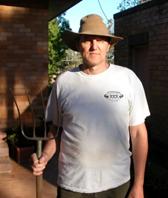 In my home state of South Australia, apart from the capital, Adelaide, almost all towns had fewer than 5,000 residents, so the main centers of higher learning and associated museums and galleries were located in that city. Up until the end of high school, my guess is I'd visited the capital—which was 160 miles away—only five or six times and then mostly on day trips. The only cultural event I recall from that era was a visit to the state Museum of Natural History and the zoo. Once I moved to Adelaide, I had access to all sorts of "cultured" places and events. However, while that often required having the price of admission, it also required the desire to not only participate in such activities, but also an investment in learning to appreciate them. And I had no background to do that. As such, I grew up a Philistine, at least in terms of fine art appreciation. [The photo at left is my Aussie version of the classic painting, American Gothic.]
In my home state of South Australia, apart from the capital, Adelaide, almost all towns had fewer than 5,000 residents, so the main centers of higher learning and associated museums and galleries were located in that city. Up until the end of high school, my guess is I'd visited the capital—which was 160 miles away—only five or six times and then mostly on day trips. The only cultural event I recall from that era was a visit to the state Museum of Natural History and the zoo. Once I moved to Adelaide, I had access to all sorts of "cultured" places and events. However, while that often required having the price of admission, it also required the desire to not only participate in such activities, but also an investment in learning to appreciate them. And I had no background to do that. As such, I grew up a Philistine, at least in terms of fine art appreciation. [The photo at left is my Aussie version of the classic painting, American Gothic.]
This multipart essay is not about culture, per se, but rather about the places and events of a cultural nature that I have visited or experienced in my 34 years of (mostly international) travel. And even though I lived in Australia for 25 years prior to that, most of my travel experiences there are from later on as a tourist traveling from my adopted country, the United States. Hopefully, you'll be inspired to click on some of the hyperlinks to learn more, as well as to think about, and hopefully visit, some of these places in person.
Ancient Civilizations and Old Sites
One of my first experiences in this category was a biggie, the "lost" Incan city of Machu Picchu, near Cuzco, in the Andes of Peru. Constructing a place like this without modern machinery must have been a huge task, especially given that the quarries where the stones appear to have come from are nowhere near the building site. The stones were cut so precisely that no mortar was needed in the joints. I had the privilege of staying at the site overnight, which meant that after the day trippers left on the afternoon train and before they returned the next morning, we few overnight guests had the place to ourselves. [I went there after a week in a base jungle camp and then a primitive camp on the Amazon River downstream from Iquitos, Peru.]
Next up were the earthen, step-pyramids in Puebla, Mexico, from the Aztec era.
On my first visit to Costa Rica, I shared a hostel room with a Norwegian who'd just arrived from the old city of Antigua in Guatemala. Up to that time, I had no knowledge of nor interest in Guatemala, but a year later, there was I. After two weeks of private Spanish lessons and some touring to Lago de Atitlán and Chichicastenango, I spent time at the Mayan pyramids at Tikal. Some are half exposed with large trees growing up and over them. Without a vantage point, there was no way to see these seemingly man-made points reaching above the surrounding jungle, so they remained unknown to the modern world for many years.
One northern winter, I spent two great weeks in the northeast part of the Yucatán Peninsula of Mexico that was formerly occupied by the Maya. I started at Tulum, a well-preserved seaside town. From there I visited the pyramid and sprawling city at Coba before going on to stay at Valladolid, the location of several impressive cenotes (sinkholes). I saved the best, the Chichen Itza complex, till last. 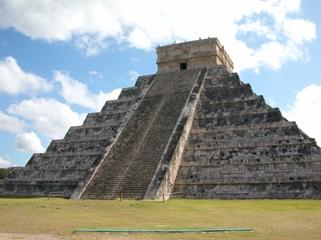 The Mayan's knowledge of astronomy and mathematics truly is impressive as is the internationally recognizable pyramid (which, fortunately, tourists can no longer climb).
The Mayan's knowledge of astronomy and mathematics truly is impressive as is the internationally recognizable pyramid (which, fortunately, tourists can no longer climb).
The first time I went to Stonehenge, visitors could walk right among the stones and touch them. It truly was a great experience to be there and to think about the purpose of the place and the impressive feat of dragging those stones from a far-away place. It really was incomprehensible that only 100 years earlier, a visitor there could rent a hammer from the local blacksmith to break off a piece of stone as a souvenir, and that farmers were crushing some of the lintels for use as gravel.
Although the English went through a more modern period of not taking baths, the Roman site of Bath is impressive as is the city now surrounding it.
A few years ago, I made my first trip to the Middle East, where I spent all my free time in Jordan. I was based in the capital, Amman, and made day trips in and around that city. Highlights included the well-preserved Roman city of Jerash (complete with arena for chariot racing, and a beautifully restored semicircular theater with uniformed musicians playing bagpipes), the ancient amphitheater downtown, and a walking tour with 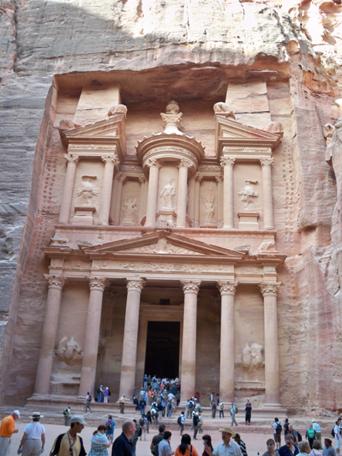 two young Palestinian women who were graduate students. While there, I learned that Amman was formerly known as Philadelphia. To be sure, the highlight of the trip was three days and two nights in Petra, the capital city of the Nabataeans built around 300 BC. [The Treasury building carved in the rock face was made world-famous by the first Indiana Jones movie.]
two young Palestinian women who were graduate students. While there, I learned that Amman was formerly known as Philadelphia. To be sure, the highlight of the trip was three days and two nights in Petra, the capital city of the Nabataeans built around 300 BC. [The Treasury building carved in the rock face was made world-famous by the first Indiana Jones movie.]
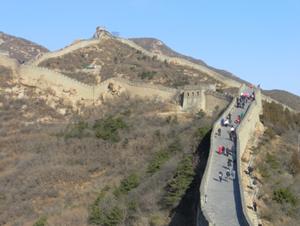 My visit to mainland China involved two weeks in Beijing, one of which was spent playing tourist. The highlights included Tiananmen Square, the Forbidden City, the Summer Palace, the Temple of Heaven, the Great Wall, and the much more recent 2008 Summer Olympics' Bird's Nest stadium. Unfortunately, I was there in December when the wind howled and the temperature did not get above freezing! I highly recommend going at a warmer time.
My visit to mainland China involved two weeks in Beijing, one of which was spent playing tourist. The highlights included Tiananmen Square, the Forbidden City, the Summer Palace, the Temple of Heaven, the Great Wall, and the much more recent 2008 Summer Olympics' Bird's Nest stadium. Unfortunately, I was there in December when the wind howled and the temperature did not get above freezing! I highly recommend going at a warmer time.
My first visit to Rome was for three days in 1979, and it was my first stop in Europe. To say that the city is an outdoor museum would be an understatement. I went back for four days in 2005. The highlights were the Coliseum and the Pantheon.
The Neolithic monument of New Grange is in the Boyne Valley of Ireland. Like a number of other sites, it is built so that the sun's light enters at noon on the midwinter's solstice. It was built 1,000 years before Egypt's pyramids.
Religious Places and Artifacts
The UK is full of religious sites, many of which are ruins from the time when Henry VIII dissolved the Catholic monasteries. The joke among people who visit such sites on one of the numerous bus tours is that "We're going on an ABC Tour, Another Bloody Cathedral!" In England, if a town has a cathedral, it's a city, which makes Ely one of the smallest English cities. Other places of note in England are Westminster Abbey (especially for all you royal wedding buffs and Da Vinci Code fans) and St. Paul's Cathedral.
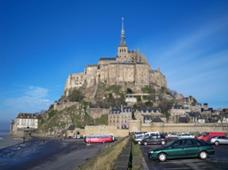 Rome boasts the Vatican City; France has Notre Dame and Mont Saint-Michelle; Leipzig, Germany, has St. Thomas Church, the final resting place of Bach; and Lutherstadt Wittenberg, Germany, has the church on whose door Martin Luther posted his theses.
Rome boasts the Vatican City; France has Notre Dame and Mont Saint-Michelle; Leipzig, Germany, has St. Thomas Church, the final resting place of Bach; and Lutherstadt Wittenberg, Germany, has the church on whose door Martin Luther posted his theses.
After traveling for 2½ weeks in South East Asia, I was pretty much overdosed with Buddhas; they were sitting, standing, reclining, made of gold, and so on. However, after a suitable break, I've since been to see a lot more Buddhist temples (and Shinto shrines) on Jeju Island of South Korea; Beijing and Hong Kong, China; and Nara, Kyoto, Tokyo, Sapporo, Miyajima (perhaps my all-time favorite, especially when the tide is in), and Kamakura, all in Japan.
On Todos Santos (All Saints Day and Halloween), I've let off firecrackers and cleared around graves in Mexico, and watched the annual parade in Chichicastenango, Guatemala.
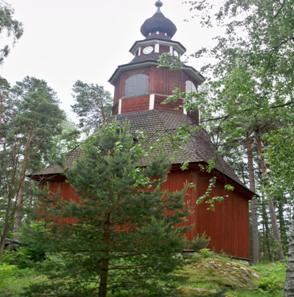 On numerous trips throughout Europe, I've attended lunchtime and/or evening organ and choir concerts in a variety of churches and cathedrals. One particular event—a woman soloist singing Ave Maria in a large church in Budapest, Hungary—sticks in my mind.
On numerous trips throughout Europe, I've attended lunchtime and/or evening organ and choir concerts in a variety of churches and cathedrals. One particular event—a woman soloist singing Ave Maria in a large church in Budapest, Hungary—sticks in my mind.
During several trips to Norway, I saw some wonderful Stave Churches, medieval wooden buildings with slate roofs. And during my two weeks in Saint Petersburg, Russia, I saw quite a few impressive Orthodox churches.
In Helsinki, Finland, the Orthodox Uspenski Cathedral and the underground Lutheran Temppeliaukio Church are worth a visit.
For an interesting and rather scathing take on religious relics, see Mark Twain's book Innocents Abroad, the first ever travel guide.